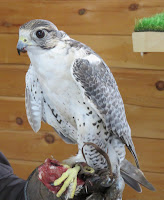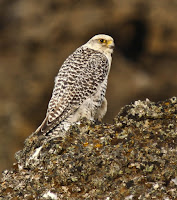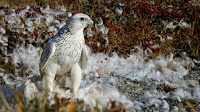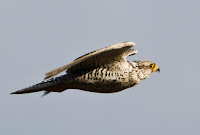GYRFALCON
GYRFALCON (Falco rusticolus) – (See images below)
DESCRIPTION: The Gyrfalcon has many different plumages that can vary from dappled white to brown to almost entirely black. Plumage is mottled or barred on top, streaked on the underside. Eyes are brown. Hooked bill is grey. Legs are grey and covered with feathers. Sexes are similar, with females larger than males. Bird length average is around 60 cm (24 inches).
VOICE: https://www.xeno-canto.org/species/Falco-rusticolus
NAME: The part ‘Gyr’ in the English name has various origins – from Germanic ‘ger’, to ‘spear’; from Latin ‘to circle’; or Germanic ‘geier’, a ‘vulture’ (Choate). Latin genus name (and English ‘falcon’ name part) means ‘sickle’, in reference to the curved shape of the bird’s bill and talons. Latin species name ‘rusticolus’ means ‘rustic’, likely in reference to the habitat type.
HABITAT: Tundra, mountains, also sea ice.
DIET: Birds and mammals, killed on the ground.
NESTING: Nest is located on a cliff ledge, can be a nest abandoned by other species. Between two and four white eggs are laid, incubated by the female. Chicks fed by both parents.
DISTRIBUTION: Breeding range in the Arctic around the globe. Winters in the tundra around the globe, some individuals can be observed in Canada and the taiga in the winter.
Distribution Map: https://commons.wikimedia.org/wiki/Category:Falco_rusticolus#/media/File:Falco_rusticolus_distr.png
ON PEI: Does not breed on Prince Edward Island, sightings occasional or rare except summer.
CONSERVATION: Because of climate change the Peregrine Falcon is expanding its northern range, directly competing with the less aggressive gyrfalcon, and overwhelming it. In spite of this the species is still globally not considered at risk.
NOTES: The gyrfalcon is the official bird of the Canadian Northwest Territories. It also adorns the Iceland coat of arms.
This falcon has been used in falconry for many centuries, initially used only by kings and nobility. Today they are very expensive, and vulnerable to avian diseases because of an ‘unprepared’ immune system.
SIMILAR SPECIES: Peregrine Falcon, Snowy Owl (female, juvenile)
REFERENCES: https://hawkwatch.org/learn/factsheets/item/368-gyrfalcon
https://www.borealbirds.org/bird/gyrfalcon
http://fieldguide.mt.gov/speciesDetail.aspx?elcode=ABNKD06080 (Montana Field Guide)
https://animaldiversity.org/accounts/Falco_rusticolus/ (University of Michigan)
http://www.luontoportti.com/suomi/en/linnut/gyrfalcon (Nature Gate Finland)
https://en.wikipedia.org/wiki/Gyrfalcon
https://www.allaboutbirds.org/guide/Gyrfalcon/id
https://www.peregrinefund.org/explore-raptors-species/Gyrfalcon
http://www.birdweb.org/birdweb/bird/gyrfalcon
https://www.audubon.org/field-guide/bird/gyrfalcon
DESCRIPTION: The Gyrfalcon has many different plumages that can vary from dappled white to brown to almost entirely black. Plumage is mottled or barred on top, streaked on the underside. Eyes are brown. Hooked bill is grey. Legs are grey and covered with feathers. Sexes are similar, with females larger than males. Bird length average is around 60 cm (24 inches).
VOICE: https://www.xeno-canto.org/species/Falco-rusticolus
NAME: The part ‘Gyr’ in the English name has various origins – from Germanic ‘ger’, to ‘spear’; from Latin ‘to circle’; or Germanic ‘geier’, a ‘vulture’ (Choate). Latin genus name (and English ‘falcon’ name part) means ‘sickle’, in reference to the curved shape of the bird’s bill and talons. Latin species name ‘rusticolus’ means ‘rustic’, likely in reference to the habitat type.
HABITAT: Tundra, mountains, also sea ice.
DIET: Birds and mammals, killed on the ground.
NESTING: Nest is located on a cliff ledge, can be a nest abandoned by other species. Between two and four white eggs are laid, incubated by the female. Chicks fed by both parents.
DISTRIBUTION: Breeding range in the Arctic around the globe. Winters in the tundra around the globe, some individuals can be observed in Canada and the taiga in the winter.
Distribution Map: https://commons.wikimedia.org/wiki/Category:Falco_rusticolus#/media/File:Falco_rusticolus_distr.png
ON PEI: Does not breed on Prince Edward Island, sightings occasional or rare except summer.
CONSERVATION: Because of climate change the Peregrine Falcon is expanding its northern range, directly competing with the less aggressive gyrfalcon, and overwhelming it. In spite of this the species is still globally not considered at risk.
NOTES: The gyrfalcon is the official bird of the Canadian Northwest Territories. It also adorns the Iceland coat of arms.
This falcon has been used in falconry for many centuries, initially used only by kings and nobility. Today they are very expensive, and vulnerable to avian diseases because of an ‘unprepared’ immune system.
SIMILAR SPECIES: Peregrine Falcon, Snowy Owl (female, juvenile)
REFERENCES: https://hawkwatch.org/learn/factsheets/item/368-gyrfalcon
https://www.borealbirds.org/bird/gyrfalcon
http://fieldguide.mt.gov/speciesDetail.aspx?elcode=ABNKD06080 (Montana Field Guide)
https://animaldiversity.org/accounts/Falco_rusticolus/ (University of Michigan)
http://www.luontoportti.com/suomi/en/linnut/gyrfalcon (Nature Gate Finland)
https://en.wikipedia.org/wiki/Gyrfalcon
https://www.allaboutbirds.org/guide/Gyrfalcon/id
https://www.peregrinefund.org/explore-raptors-species/Gyrfalcon
http://www.birdweb.org/birdweb/bird/gyrfalcon
https://www.audubon.org/field-guide/bird/gyrfalcon
 |
| Gyrfalcon, Island Falconry Services |
 |
| Gyrfalcon, by Ólafur Larsen |
 |
| Gyrfalcon, Westgronland, NorthernLight |
 |
| Gyrfalcon in flight, Ómar Runólfsson |
 |
| Gyrfalcon nestling, USFWS AK |